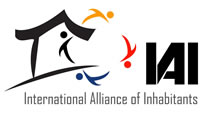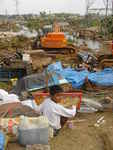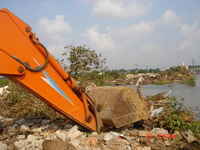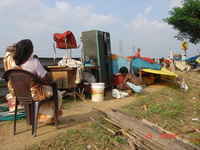Forced evictions in Chennai (Madras) – Demolition renders 30,000 homeless in Tamil Nadu, India
About one million people are threatened
PASUMAI THAAYAGAM (Green Mother Land), a NGO in Special Consultative Status with the Economic and Social Council of the United Nations (ECOSOC), has reported that a demolition drive by authorities has made around 30,000 people homeless in Chennai, Tamil Nadu, India, including around 5,000 students.
Porur Lake Area
Chennai, formerly known as
Madras, is the capital of the state
of Tamil Nadu
and is India
's fourth largest
metropolitan city. With an estimated population of 6.96 million (2006), the 368-year-old city is the 34th largest metropolitan area
in the world. More then 26 percent of the population live in slums.
Porur is a small township that lies in the extended region of Chennai city. It is primarily one of the residential areas of Chennai metropolitan area. The Porur Lake, which is situated in Porur, is one of the primary water resources for people residing in Chennai
. Porur Lake Area slum is on the lake, which lies on the border between Thiruvallur and Kancheepuram districts. This slum area is divided into Ambedkar Nagar, West Ambedkar Nagar, Samathuva Nagar (part of Thiruvallur District) Selvaganapathy Nagar, Anna Nagar (part of Kancheepuram District).
For further information, see the following:
Wikipedia article about Porur
.
Satellite picture of Porur Lake
.
Satellite picture of evicted area, south side of Porur Lake
Forced Eviction
The people who were living in the Porur Lake area were forcefully evicted without any prior notification or announcement. Between 23 and 25 of November 2006 police personnel arrived in large number with earth movers and bulldozers to demolish all the settlements. It was particularly shocking for these people that such a thing could happen when all government officials had promised them full facilities and when the area had already been provided with a full electricity supply, a sub post office, and public call offices.
People had no time to remove their valuables from their houses, and have lost all the household materials which they had accumulated over many years. Some people were not even able to take their children’s certificates. A three-year-old girl fell into the water and died, and two people died of heart attacks.
Background
These families have been settled around this lake for over fifteen years. According to law they are illegal encroachers. These so-called ‘encroachments’ usually follow a familiar pattern. First, land grabbers, in connivance with political parties, encourage landless people to "book" their plots of choice after a nominal payment. Once there are enough "bookings," the construction of thatched huts begins with the blessings of lower level staff in the Revenue department.
`No Objection Certificates' are obtained in order to apply for necessary amenities. Local bodies grant their approval for the formation of new residential localities, despite being fully aware of the violations. Revenue officials issue a 'B' memo, which is merely a receipt for the sum received from encroachers as a fine for illegally occupying government property. Using the ignorance of most dwellers in such places, land grabbers convince people that such memos are indicators of ownership of land.
According to the law, the Porur Lake area slums are illegal encroachments, as the state government imposed a total ban on any form of construction on any water resource in 2002.
There is no specific court order against the Porur Lake area slums, but many court orders support eviction. The Government simply claims that court orders back the removal of encroachments anywhere in the state. The bulldozing began after the Supreme Court upheld the Madras High Court's order to remove 32,000 illegal and unauthorized constructions in the city. (There is no detail whether the Porur Lake area slums are included in the 32,000 unauthorized constructions in Chennai.)
No Rehabilitation
People are out in the open with whatever belongings they managed to salvage from the demolished site. Women and children are sitting under the scorching sun with no provision for alternate housing. The authorities had no rehabilitation plans in place prior to the eviction drive. The lack of any proper eviction plan or rehabilitation process has led to widescale suffering, with people living in the streets and children unable to attend school.
The Government gave assurance after the eviction that the affected families would receive 2.000 rupees each (USD 45), and a piece of land outside of the city. However, some of the sites earmarked for rehabilitation are more then 20 km away from the eviction location. Many people have been forced to sell their basic belongings just to survive from day to day and because people work nearby and most of them depend on the city for their livelihoods, they are not willing to move to the new site.
National and International Human Rights Law Violations
The demolition in Porur lake area is a blatant violation of the human right to adequate housing. These forced evictions without adequate rehabilitation violate the affected people’s fundamental right to life and livelihood as enshrined in Article 21 of the Indian Constitution. Reaffirming the principle of indivisibility of all human rights, the fundamental right to life encompasses the right to live with human dignity. Furthermore, Article 14 of the Constitution of India guarantees equal protection under law.
The demolition also contradicts the United Progressive Alliance (UPA) government’s Common Minimum Programme (CMP), proposed in May 2004. The CMP specifically states: “Forced eviction and demolition of slums will be stopped and, while undertaking urban renewal, care will be taken to see that the urban and semi-urban poor are provided housing near their place of occupation.”
Besides contradicting the National government's Common Minimum Programme, the actions against the people of Porur lake area constitute a violation of their basic human rights to life, security, health, work, and adequate housing; i.e., the right of all women, men and children to gain and sustain a secure place to live in peace and dignity. The authorities have especially violated people’s entitlements to security of tenure and freedom from forced evictions; access to and benefit from public goods and services; information, capacity and capacity building; participation and self-expression; rights to resettlement and adequate compensation for violations and losses; and physical security and privacy. All are elements of the human right to adequate housing as recognized in international law.
By these evictions, the Indian authorities, including the local authorities, have breached their treaty obligations under, inter alia, Articles 2, 11, 12, 13 and 15 of the International Covenant on Economic, Social and Cultural Rights (ICESCR), to which India acceded in 1979. The State has been derelict in its obligations as elaborated in the UN Committee on Economic, Social and Cultural Rights General Comments No. 4 on the right to adequate housing and No. 7 on forced evictions. The State of India has also contravened its obligations under Articles 16, 27 and 39 of the Convention on the Rights of the Child (CRC) to which it acceded on 11 December 1992, despite the Concluding observations on India adopted by the Committee on the Rights of the Child at its thirty-fifth session of 26 February 2004 that, "the Committee further recommends that the State party prevent any occurrence of forced relocation and other types of involuntary population movements.”
They are also in violation of Article 14 of the Convention on the Elimination of all Forms of Discrimination against Women (CEDaW), which it ratified on 9 July 1993. Furthermore, the evictions constitute a gross violation of the objectives of the Millennium Development Goals (MDGs), specifically the target to have achieved by 2020 a significant improvement in the lives of at least a hundred million slum dwellers, and of the new Basic Principles and Guidelines on Development-based Evictions and Displacement issued by the UN Special Rapporteur on Adequate Housing of the UN Commission on Human Rights.
One million evictions waiting to happen
On December 2, 2006, the State Government formed panels at the State and district level to initiate time-bound action for removal of encroachments on Government land. So, about one million people are threatened by evictions waiting to happen all over the state of Tamil Nadu.
Urgent Solidarity Action Requested:
In this context, Pasumai Thaayagam (Green Motherland), and Centre for Social Work and Research (CSWR), together with the International Alliance of Inhabitants, are launching a 'Campaign for Housing Rights and Zero Eviction' in Tamil Nadu, India.
>>> Please show your solidarity by signing the Appeal to the authorities in India urging them to respect their obligations under national and international law to protect, promote and fulfil the human right to adequate housing!.
We are also requesting the United Nations, particularly the UN-Habitat, the G8 and creditor countries to India, to take immediate action.



